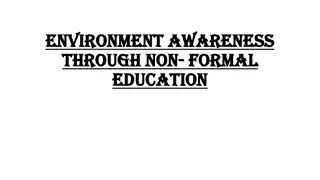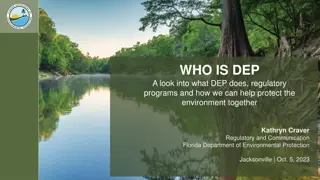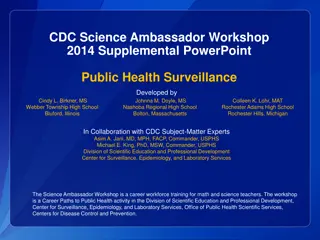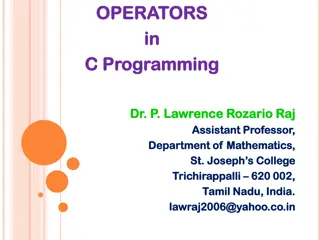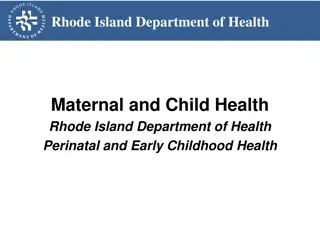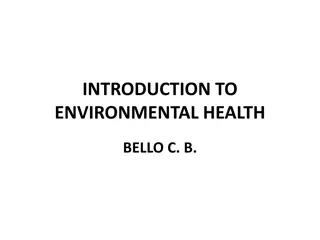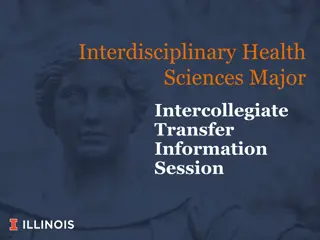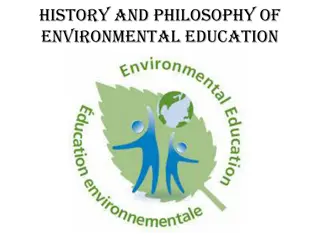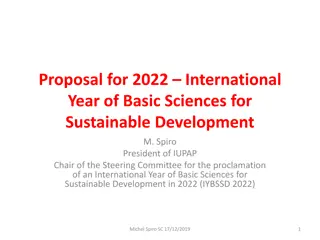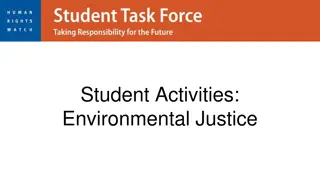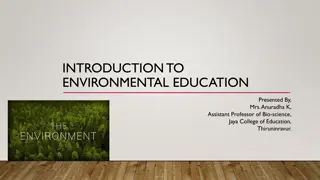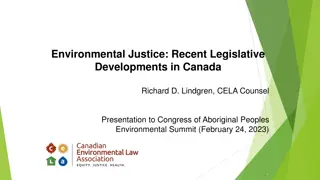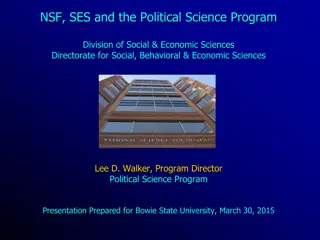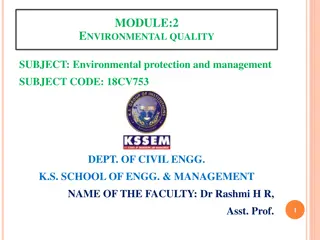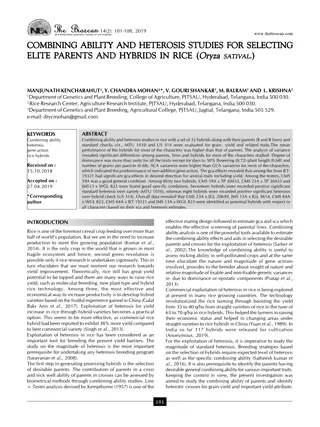Division of Environmental Health Sciences: Improving Public Health through Research and Education
The Division of Environmental Health Sciences aims to enhance individual and community health by conducting research, identifying risks, reducing hazards, informing policies, and providing interdisciplinary education. Their projects cover a wide range of environmental health issues, from infectious diseases to climate change, focusing on understanding exposures, effects, and susceptibility. Through collaborative efforts and rigorous research, they work towards creating a world where environmental justice and health equity prevail. Their work encompasses areas such as food safety, injury prevention, epidemiology, and policy evaluation. Visit their website to learn more about their impactful projects and initiatives.
Download Presentation

Please find below an Image/Link to download the presentation.
The content on the website is provided AS IS for your information and personal use only. It may not be sold, licensed, or shared on other websites without obtaining consent from the author.If you encounter any issues during the download, it is possible that the publisher has removed the file from their server.
You are allowed to download the files provided on this website for personal or commercial use, subject to the condition that they are used lawfully. All files are the property of their respective owners.
The content on the website is provided AS IS for your information and personal use only. It may not be sold, licensed, or shared on other websites without obtaining consent from the author.
E N D
Presentation Transcript
WHO we are and WHAT we do Understanding individual effects and susceptibility EXPOSURE SCIENCE VISION A world in which environmental justice and health equity prevail. INFECTIOUS DISEASES OCCUPATIONAL HEALTH TOXICOLOGY CLIMATE CHANGE MISSION The Division of Environmental Health Sciences improves the health of individuals and communities by conducting rigorous and collaborative research to identify risks, reduce hazards, and inform public health policies, and by providing outstanding interdisciplinary education to prepare future environmental health practitioners and leaders. Assessing environmental exposures Understanding effects on communities and populations FOOD SAFETY INJURY AND VIOLENCE EPIDEMIOLOGY AND PREVENTION Informing and evaluating policies and practices, community empowerment, health and wellness equity Division of Environmental Health Sciences (EnHS)
WHO we are and WHAT we do Examples of projects Drought and Occupational Psychosocial Stress among Farmers [J. Berman] Great Plains Center for Agricultural Health Extreme weather is a growing health threat, but the impacts from drought are poorly understood. We found drought to be a risk factor for increased work-related mental stress among Midwest farmers. Our work will inform drought early warning plans. Prevalence of SARS-CoV-2 antibodies in MN Grocery Store Workers [C. Hedberg] Minnesota Department of Health This study established prevalence estimates for SARS-CoV-2 seropositive status among MN grocery store workers and will measure vaccine status, attitudes, and uptake among this group of essential workers. Effect of the microbiome upon deer tick range expansion in the Upper Midwest [J. Oliver] MN Futures Deer tick range expansion and pathogen infection is driven by environmental conditions and internal microbiotic factors. We are working to discover how these factors and drive colonization of new territories by ticks, pathogen infection of ticks, and transmission of tick- borne diseases. Link for Equity [M. Ramirez] National Institute of Minority Health and Disparities This study evaluates the effect of Link for Equity, a culturally responsive trauma- informed care intervention designed to reduce the impacts of childhood adversities, including from racism and community violence, and reduce violence disparities among youth of color. Division of Environmental Health Sciences (EnHS)
WHO we are and WHAT we do PROJECT IMPACT KEY: Metrics, Outbreak Evaluation, Scholarships and Integrated Food Safety Centers of Excellence (CoE) Activities [C. Hedberg] MDH (CDC prime) / H1201-3000068209 The CoE serve as resources for public health professionals who conduct surveillance for food-borne illnesses and investigate outbreaks. The CoE develop tools, deliver trainings, and evaluate the effectiveness of outbreak investigations to strengthen efforts to prevent future illnesses and outbreaks. Drought and Occupational Psychosocial Stress among Farmers [J. Berman] Great Plains Center for Agricultural Health Extreme weather is a growing health threat, but the impacts from drought are poorly understood. We found drought to be a risk factor for increased work-related mental stress among Midwest farmers. Our work will inform drought early warning plans. The DNA adductome of lung carcinogenesis [S. Balbo] NIH/NCI R01CA220376 This study uses state of the art high resolution mass spectrometry DNA adductomic techniques to structurally characterize the DNA damage in the lung carcinogenic process. The results from this study will help to identify more effective preventive, therapeutic and diagnostic strategies for lung cancer. Individuals Community Environment Policies Evaluation of Drought Indicators for Improved Public Health Decision Making [J. Berman] NOAA CPC Developing hazard messaging and response plans require reliable information. Our focus is to evaluate drought indices with various health outcomes to identify discrepancies in risk and inform regional risk management plans. Evaluation of Health Department Restaurant Inspection Programs [C. Hedberg] NEHA (CDC prime); U38OT000300-01-01 This project evaluated restaurant inspection programs, identifying public posting of inspection results at the point of service as a best practice that can improve food safety. Air Pollution and Violent Behavior [J. Berman] Violence is a leading cause of death and injury, but environmental causes of violence are poorly understood. In a large national study, we identified that air pollution is linked to increased violent criminal behavior. Division of Environmental Health Sciences (EnHS)
WHO we are and WHAT we do PROJECT IMPACT KEY: Firearm Violence [M. Ramirez] Office of Academic Clinical Affairs (OACA) This longitudinal study follows Minnesota children from early childhood through adulthood to identify the individual and environmental factors that predict involvement in firearm violence perpetration. Prevalence of SARS-CoV-2 antibodies in MN Grocery Store Workers [C. Hedberg] Minnesota Department of Health This study established prevalence estimates for SARS-CoV-2 seropositive status among MN grocery store workers and will measure vaccine status, attitudes, and uptake among this group of essential workers. Link for Equity [M. Ramirez] National Institute of Minority Health and Disparities This study evaluates the effect of Link for Equity, a culturally responsive trauma- informed care intervention designed to reduce the impacts of childhood adversities, including from racism and community violence, and reduce violence disparities among youth of color. Individuals Community Environment Policies Optimizing Assessment of Virus- Containing Particles in Animal Agriculture [P. Raynor] NIOSH / U54OH010170 The objectives of this research are to develop a high-volume, field-portable, size- differentiating viral aerosol sampler and use it to measure worker exposures to viable airborne influenza viruses in animal agriculture facilities. With accurate measurements, we can assess ways to minimize exposures. Effect of the microbiome upon deer tick range expansion in the Upper Midwest [J. Oliver] MN Futures Deer tick range expansion and pathogen infection is driven by environmental conditions and internal microbiotic factors. We are working to discover how these factors and drive colonization of new territories by ticks, pathogen infection of ticks, and transmission of tick-borne diseases. Effectiveness of Anti-bullying Laws [M. Ramirez] CDC -National Center for Injury Control and Prevention This study assesses the implementation and impacts of anti-bullying laws on reducing youth violent behaviors, including bullying and fights in schools. The study involves close collaboration with the Maine Department of Education. Division of Environmental Health Sciences (EnHS)
WHO we are and WHAT we do PROJECT IMPACT KEY: Evaluating a Pandemic s Impact on Gig-Workers: How Is Health and Well-Being Affected by COVID-19? [P. Raynor] NIOSH / T42OH008434 (to E. Avila) This research seeks to identify health and safety perceptions among gig-workers, and determine the impact COVID-19 has had on gig-workers well-being. Minnesota HHEAR Targeted Analysis Laboratory [L. Peterson] NIEHS / U2CES026533 This program brings together experts from the University of Minnesota and the Minnesota Department of Health to provide a national resource for exploring environmental, lifestyle, and related factors that can affect human health. The outcomes of projects conducted through HHEAR will lead to more effective disease prevention strategies. Promoting Safety and Worker Health for Immigrant Dairy Workers [J. Bender] CDC-NIOSH (3U54OH010170-07S1) The goal of this project is to improve the occupational health and safety of Minnesota s growing immigrant dairy workforce through a train-the- trainer and a community health worker (CHW) model. This involves incorporating a One Health approach, employing a multidisciplinary team of clinicians, veterinarians, producers, workers and community health centers. Individuals Community Environment Policies Surveillance and Investigation of SARS-CoV-2 in Animals, Minnesota [J. Bender] CDC-CSTE The focus of this study is the creation of a timely surveillance system to detect SARS- CoV-2 in companion animals, shelter animals, and wildlife. Stress Tolerance in Campylobacter and its Impact on Food Safety [B. Jeon] Campylobacter is the leading foodborne pathogen in the U.S. Our laboratory investigates the mechanisms for Campylobacter survival under stress conditions during food processing and its effect on food safety and public health. Division of Environmental Health Sciences (EnHS)
WHO we are and WHAT we do PROJECT IMPACT KEY: Food Safety Interventions to Control Listeria Biofilm [B. Jeon] Healthy Foods, Healthy Lives Institute Listeria monocytogenes is the foodborne pathogen showing the highest rates of case fatality and hospitalization in the U.S. This project aims to address food safety issues associated with Listeria biofilms using phylogenetic, epidemiological, and molecular microbiological approaches. Individuals Community Environment Policies Antibiotic Alternatives to Control Resistant Pathogens [B. Jeon] Widespread antibiotic-resistant pathogens significantly compromised the efficacy of existing antimicrobial therapies. This project aims to develop new antimicrobial therapeutic approaches using antimicrobial synergy with natural phytocompounds and bacteriophages, which are bacteria-infecting viruses. Division of Environmental Health Sciences (EnHS)
Forming collaborations and partnerships across the University, and impacting local, state, regional, national and global communities. How do we collaborate? EnHS faculty play major roles in many centers and institutes within our division, and across the University. NATIONAL AND GLOBAL STATE AND REGIONAL Centers housed in the Division of Environmental Health Sciences University partners with EnHS faculty in leadership roles Exposure Science and Sustainability Institute (ESSI) Center for Infectious Disease Research and Policy Midwest Consortium for Hazardous Waste Worker Training Masonic Cancer Center Institute for Global Cancer Prevention Research Midwest Occupational Health and Safety Education and Research Center (MCOHS) Centers for Disease Control Minnesota Department of Health Other University partners World Health Organization Minnesota Food Safety Center of Excellence Center for Animal Health and Food Safety Agriculture and Agri-Food Canada Minnesota Department of Labor and Industry Minnesota Technical Assistance Program (MnTAP) College of Veterinary Medicine Medical School Upper Midwest Agricultural Safety and Health Center Minnesota Population Center Division of Environmental Health Sciences (EnHS)
Environmental Health Sciences faculty have collaborated with partners in academia, business and industry, and government at the local, state, national and international level through research, outreach, and education. Our connections Universities and Academic Organizations Government Business and Industry Division of Environmental Health Sciences (EnHS)
How do we function? FACULTY SUPPORT Division COMMITTEES ADDITIONAL SUPPORT SERVICES Weekly LUNCH & LEARN Meetings Research Education and Curriculum Faculty mentoring Diversity, Equity and Inclusion Pre-award support Laboratory Finance Strategic discussions about EnHS mission and direction Recruitment Student program coordinators Admissions Administrative assistance Discussion of new initiatives Web and graphic design Brainstorming research ideas and grant proposals IT support Invited presentations Faculty development events Meetings with SPH leadership Other Division of Environmental Health Sciences (EnHS)
How do we function? STUDENT SUPPORT Student Support RESOURCES ADDITIONAL SUPPORT SERVICES Program Coordinator Graduate School Graduate Student Services and Progress (GSSP) International Student Services Student Counseling Services Internships Student Academic Success Services NIOSH Traineeships Center for Writing Support Student Conflict Resolution Center Career Services Scholarships University Libraires Effective U Guidebooks Student Mental Health One Stop Student Services Advocacy and Support Group Advising Council of Graduate Students (COGS) Program Tracks Disability Resources Center Student Parent Help Center Gender and Sexuality Center for Queer and Trans Life Boynton Health BIPOC Mental Health Collective Division of Environmental Health Sciences (EnHS)




